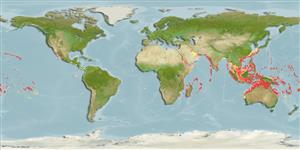Common names from other countries
Teleostei (teleosts) >
Holocentriformes (Squirrelfishes, soldierfishes) >
Holocentridae (Squirrelfishes, soldierfishes) > Holocentrinae
Etymology: Sargocentron: Greek, sargos = sargus + Greek, kentron = sting (Ref. 45335).
More on author: Cuvier.
Environment: milieu / climate zone / depth range / distribution range
Ecology
Marine; reef-associated; depth range 0 - 183 m (Ref. 9710), usually 1 - 30 m (Ref. 9710). Tropical; 32°N - 28°S
Indo-Pacific: Red Sea and Algoa Bay, South Africa (Ref. 4201) to the Hawaiian and Easter islands, north to southern Japan and the Ogasawara Islands, south to northern Australia and the Austral Islands.
Size / Weight / Age
Maturity: Lm ? range ? - ? cm
Max length : 23.0 cm TL male/unsexed; (Ref. 30874)
Dorsal spines (total): 11; Dorsal soft rays (total): 12 - 14; Anal spines: 4; Anal soft rays: 8 - 9. Body reddish silver, iridescent bluish above; scales finely dotted with black; spinous dorsal silvery white, with broad red margin (Ref. 4201). Five oblique scale rows on cheek; body depth 2.7-3.15 in SL; head length (HL) 2.75-3.1 in SL; snout length 4.0-4.65 in HL; interorbital width 3.6-4.05 in HL; small mouth terminal to slightly inferior, maxilla reaching from below front of iris to below center of eye, upper jaw length 2.7-3.15 in HL; premaxillary groove reaching to about a vertical at the front edge of orbit; anterior end of nasal bone rounded; medial margin of nasal bone without spinule; small nasal fossa without spinules on its edge; upper edge of suborbital bone below the eye weakly serrated, spineless laterally; short preopercular spine 1/2-3/4 orbit diameter, 4.75-6.45 in HL; 3rd-5th dorsal spine longest 2.0-2.3 in HL; 3rd anal spine 1.2-1.55 in HL (Ref. 27370).
Inhabits surge-swept tunnels and crevices of the reef margin and reef front. Rarely occurs below 30 m, but has been observed at depths of 101 to 183 m in the Hawaiian Islands (Ref. 1602); majority of specimens collected in less than 3 m, often in tide pools (Ref. 27370). Benthopelagic (Ref. 58302). It disperses at night over sand flats and open reef bottom to feed on small crustaceans, crustacean larvae, and polychaete worms. Spine of preopercle venomous. Minimum depth reported taken from Ref. 30874.
Life cycle and mating behavior
Maturities | Reproduction | Spawnings | Egg(s) | Fecundities | Larvae
Randall, J.E., 1998. Revision of the Indo-Pacific squirrelfishes (Beryciformes: Holocentridae: Holocentrinae) of the genus Sargocentron, with descriptions of four new species. Indo-Pac. Fish. (27):105 p. (Ref. 27370)
IUCN Red List Status (Ref. 130435)
CITES (Ref. 128078)
Not Evaluated
Human uses
Fisheries: commercial; aquarium: commercial
Tools
Special reports
Download XML
Internet sources
Estimates based on models
Preferred temperature (Ref.
115969): 24.8 - 29, mean 27.7 (based on 1152 cells).
Phylogenetic diversity index (Ref.
82804): PD
50 = 0.5000 [Uniqueness, from 0.5 = low to 2.0 = high].
Bayesian length-weight: a=0.01349 (0.00840 - 0.02167), b=2.98 (2.84 - 3.12), in cm Total Length, based on LWR estimates for this species & Genus-body shape (Ref.
93245).
Trophic level (Ref.
69278): 3.4 ±0.4 se; based on diet studies.
Resilience (Ref.
120179): High, minimum population doubling time less than 15 months (Preliminary K or Fecundity.).
Fishing Vulnerability (Ref.
59153): Low vulnerability (13 of 100).
